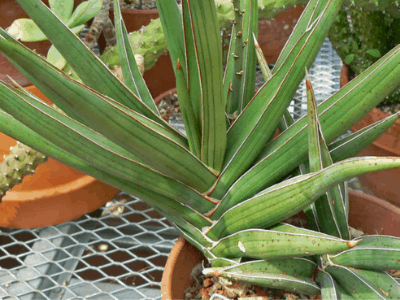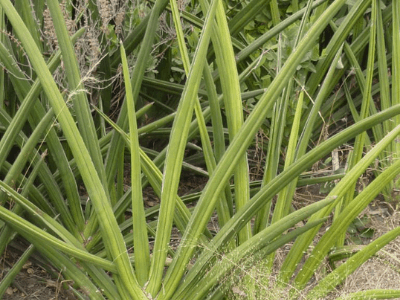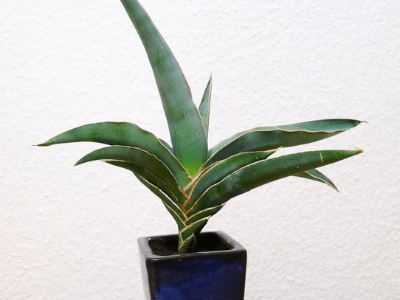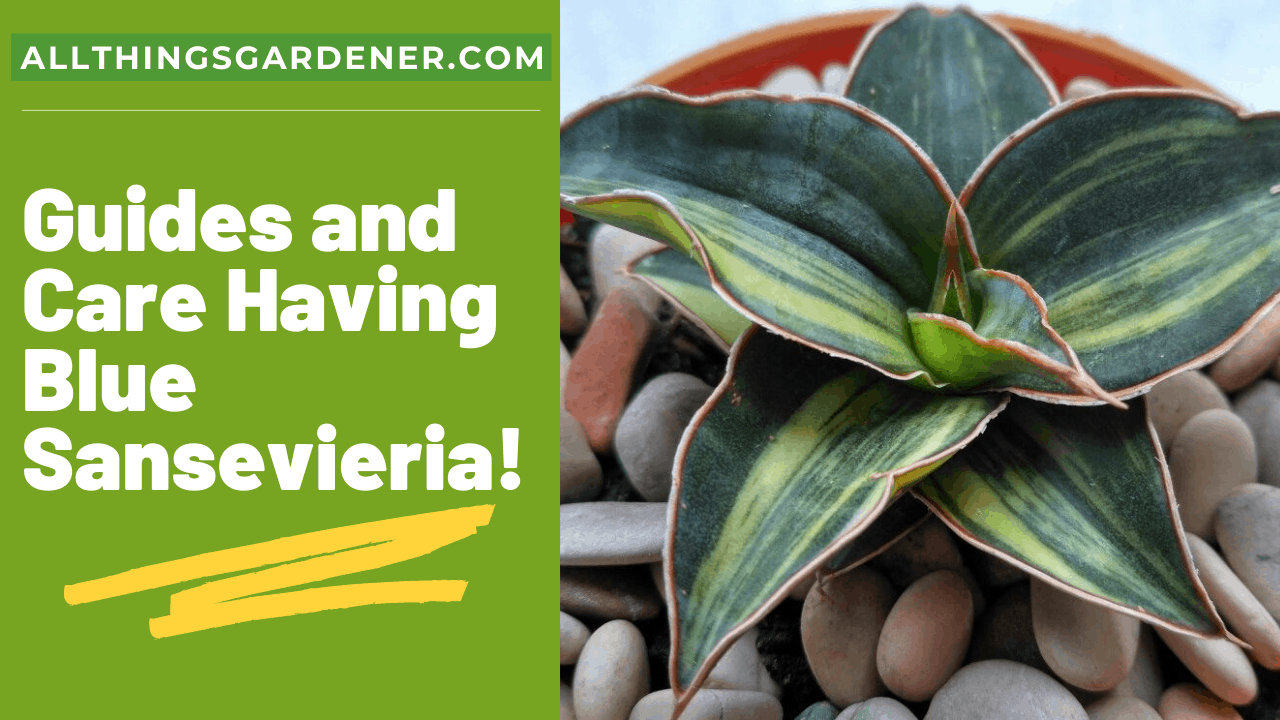Scientific Name
Sansevieria ehrenbergii Schweinf. ex Baker

Common Names
Blue Sansevieria, Sword Sansevieria, Seleb Sansevieria, East African Wild Sisal, Somaliland Bowstring Hemp
Synonyms
- Acyntha ehrenbergii
- Acyntha rorida
- Dracaena hanningtonii
- Pleomele hanningtonii
- Sanseverinia rorida
- Sansevieria rorida
Description
Sansevieria ehrenbergii is a perennial succulent that bears its leaves in 2 opposite rows..
..forming a sparse fan-shape.
It grows a short stem that can reach 7.2 inches (18 cm) in length.
Mature leaves are dark green..
..rounded in cross-section with a grooved channel on the inner side…
…and up to 5 feet (1.5 meters) long and 3.2 inches (8 cm) wide.
Rhizomes offset the plant, resulting in tight…
….relatively dense clusters. The flowers are purple-tinged grayish-white or grey-green.
Here we have story from Kemal…
…about his friend experience having Sansevieria ehrenbergii a.k.a Blue sansevieria as his houseplant!
Let us hear Kemal’s story
I had a friend that always loved having plants in her house.
She was the type of person who would bring home flowers…
….from the grocery store and put them on display for everyone to see..
..then never water or take care of them again.
I remember being over at her house once..
..and she proudly showed me a this unique plant sitting on top of her bookshelf.
“What is this?” I asked as my eyes were drawn to its color.
“This is Blue Sansevieria! It’s so rare…
….you can’t find it anywhere but online!” she said with excitement in her voice.
From then on, we referred to it as “Blue”. Magically in just 4 month..
..Blue is growing bigger than usual…
…and this is out of our expectation about this plant!

Leaf development begins at the center of the plant. Each leaf forms atop the one beneath it, but goes the opposite direction. This layering effect is quite beautiful, creating a zig-zag pattern along the stem. Full-sized blue sansevierias can have leaves up to 5 feet in length. These leaves are often aged and rotted down to produce fibers used for making string or cloth.”
Kevin Espiritu, founder from epicgardening.com
Here’s the main thing…
Hardiness
USDA hardiness zones 10b to 11b: from 35 °F (+1.7 °C) to 50 °F (+10 °C).
Sansevieria Samurai Care Secrets Revealed!
The growth patterns of this perennial succulent are known for being unusual.
It’s also known as the Sansevieria Samurai…
….the Sword Sansevieria, and the Blue Sansevieria.
Even a miniature cultivar known as the Samurai Dwarf exists…
…for this eye-catching plant.
The Sansevieria Samurai is a plant that grows in arid areas of tropical Africa and Asia.
Christian Ehrenberg, a German naturalist, was the inspiration for the name.
Sansevieria Ehrenburgii now belongs to the genus Dracaena.
The Sansevieria Ehrenbergii can be recognized…
….by its unique appearance.
Its blade-like leaves are stacked and fan out in two rows in a zig-zag pattern.
The thick and pointy leaves of this plant have a reddish-brown edging.

Soil
Wet soil is the biggest nightmare of the Sansevieria Samurai.
Sansevieria Ehrenbergii holds water in its leaves…
…just like other succulents of its sort.
Your Sansevieria Samurai should be potted in a sandy, permeable…
…and fast-draining soil to thrive.
It would be best to use a grainy succulent potting mix.
This soil mix has enough structure to support your plant while allowing for drainage.

Next up…
Light
This is a plant that thrives in direct sunlight.
Your Sansevieria Samurai comes alive under bright light.
However, this is a hardy plant that can withstand almost any situation.
Your Sansevieria Ehrenbergii will thrive in every environment, from direct sunlight to deep shade.
This plant thrives in shady or semi-shaded situations if cultivated outside in tropical climates.
The Sansevieria Samurai enjoys strong indirect light when kept indoors.
When you keep your Sansevieria Ehrenbergii in the best light possible, you can expect it to develop faster.

Watering
It’s simple to keep your Sansevieria Samurai happy.
Overwatering is the secret to a happy…
…robust Sansevieria Ehrenbergii.
This is a drought-tolerant plant that requires only 1 to 2 weeks of watering.
Watering should be done once a month throughout the winter.
Before giving your Sansevieria Samurai extra water…
…make sure it doesn’t need it.
Before watering your Sansevieria Ehrendergii..
..make sure the soil is absolutely dry.
Waterings that are thorough and infrequent are good.
It is best to water your Sansevieria Samurai thoroughly.
When water begins to drip through the drainage holes, come to a halt.
Allow your Sansevieria Ehrenbergii…
…..to completely drain before discarding the water in the saucer.
Do not submerge the pot in water.
When the Sansevieria Samurai is left in overly damp soil, it develops root rot.

Go on…
Temperature
This bold plant is forgiving and can withstand temperature changes.
In general, the Sansevieria Ehrenbergii…
….thrives in temperatures that are conducive to human comfort.
Average to warm temperatures…
…of 15 °C to 29 °C (60 °F to 85 °F) are preferred.
Your Sansevieria Ehrenbergii will begin experiencing damage…
…from temperatures below 10 °C (50 °F). Hardy but not indestructible..
..leaving a Sansevieria Samurai in wet soil…
….and exposed to extreme cold is fatal.
Frost is better avoided.
Indoor, cold drafts are also something to keep your Sansevieria Ehrenbergii away from.
Humidity
The Sansevieria Ehrenbergii requires very little fertilizer.
The optimum time to feed your Sansevieria Samurai…
….is during the growing season.
During this time, fertilizing is only required once a month.
This plant’s active growth seasons are known to be spring and summer.
On a hot day, set your Sansevieria Ehrenbergii’s pot on a watered pebble tray.
The humidity in the air around your plant will be increased with this strategy.
Fertilizer
The Sansevieria Ehrenbergii requires very little fertilizer.
The optimum time to feed your Sansevieria Samurai…
…is during the growing season. During this time, fertilizing is only required once a month.
This plant’s active growth seasons are known to be spring and summer.
It’s best to use a balanced liquid succulent fertilizer or a water-soluble fertilizer.
To avoid overwatering your plant, a watering session should be substituted with fertilizer.
In the winter, fertilizing should be avoided entirely.
Keep reading…
Propagation
It’s not difficult to propagate your Sansevieria Ehrenbergii.
There are several mechanisms for propagation…
…the simplest of which is division.
Leaf and rhizome cuttings, as well as offsets, are other potential ways…
…to propagate your Sansevieria Samurai.
Growth
Sansevieria Ehrenbergii, like others in its genus, is a slow-growing plant.
The plant grows more actively…
…in warmer climes, such as Spring and Summer.
Growth, on the other hand, decreases substantially in the winter.
The Sansevieria Samurai’s leaves grow to be long and curved as they stretch outwards.
The Sansevieria Ehrenbergii’s leaf development begins in the centre, unlike other plants.
The tips of the leaves are known to brown since it grows from the bottom up. Sansevieria Samurai leaves…
…can grow to be up to 1.5m (5ft) long and 8cm (3.5in) wide when fully grown. Sansevieria Ehrenbergii miniature…
….or dwarf cultivars are much smaller and compact. They only reach a height of 10.2cm (4in) to 15.2cm (6in)…
…and a width of around the same. The leaves of the Blue Sansevieria are blueish-green in hue…
….earning it the nickname “Blue Sansevieria.” The Sansevieria Ehrenbergii leaves have a reddish brown…
…and white colour around the edges and tips. The Sansevieria Samurai blooms, despite its rarity.
Keep reading…
The swirling clusters of flowers produced by this plant are unusual. Colors range from grayish-white to grey-green…
…with a purple tinge on rare occasions. The flowers of the Sansevieria Ehrenbergii bloom only at night.
Growing difficulties in Sansevieria Ehrenbergii are extremely unusual. Overwatering and extremely cold temperatures…
…are the only problems. The Sansevieria Samurai is not cold-tolerant and will succumb quickly.
Sansevieria Samurai dwarf leaves are significantly smaller and more compact. Even though they are little…
….they nonetheless form a fan or blade-like structure. The leaves of these stubbier varieties come in…
….either variegated colour or pure green. Banana, a dwarf cultivar variety, is also available.
The Sansevieria Ehrenbergii Banana plant has leaves that are shaped like bananas.
Potting
Sansevieria Ehrenbergii is a plant that can be used both indoors and outdoors. Because this plant is top-heavy…
….hefty clay pots are perfect. Drainage holes are required in whichever pot you select for your Sansevieria Samurai.
Because Sansevieria Ehrenbergii is a slow-growing plant, you won’t need to repot it very often.
If the plant’s development is forcing the pot to lean, repotting may be necessary.
It’s time to repot your Sansevieria Samurai if it’s becoming congested and rootbound.
This plant, on the other hand, adapts well to being rootbound and is more likely to produce blossoms as a result.
When selecting a new pot for your Sansevieria Ehrenbergii, choose one that is wide. Your plant’s long blades…
….will be better supported in a large pot. When it’s time to repot your Sansevieria Samurai…
….you can trust on it to let you know. It’s better to use a clay container because…
…it won’t crack when your plant outgrows it.
Last but not least…
Sansevieria Ehrenbergii In-depth Propagation Guide
Who wouldn’t want to get their hands on more of these plants with such a distinct appearance?
The Sansevieria Samurai is relatively simple to propagate. You can experiment with a few different…
…propagation strategies. Division is the most straightforward method of spreading your Sansevieria Ehrenbergii.
Plant division is a straightforward process. Excess soil should be wiped off the roots once it has been taken…
…from its pot or the ground. After that, you should be able to easily divide your Sansevieria Samurai into clumps.
Each clump should have its own root system and leaf fan. Individually, these clumps can then be planted.
You almost there…
Sansevieria Ehrenbergii can produce offsets on occasion. The offsets are easily distinguished from the parent plant.
Allow the offset to grow and create more full roots before replanting it. Leaf cuttings are another…
…more straightforward way to reproduce your Sansevieria Samurai. When making cuttings, choose a healthy…
…mature leaf. Cut the leaf into pieces that are at least 10 cm long. To keep the cut end from decaying…
….give it time to scab over. It may take a few days for the cuttings to dry, but once they are, you can plant them.
You can use a succulent potting mix to plant your Sansevieria Ehrenbergii leaf cuttings in.
The cuttings should be pushed into the soil around 3 cm (1in) deep. The soil should be kept very slightly damp…
…until the roots have established.
Sum Up
See having snake plant is good choice for you to have! It’s cool, its famous, it’s easy to have and care!
What else do you need? In this pandemic time like this, is a good choice for you to have an new activity…
…and having snake plant is a good choice for you to have!
Conclusion
Last thing for sure. This plant need to be care carefully, remember plant need the “love” too.
This succulent is a fantastic plant for kids. It’s a great place to start!Because the Sansevieria Ehrenbergii is so forgiving…
… it’s an excellent plant to learn how to care for. Children, on the other hand shouldn’t have all of the fun with these plants!
The Sansevieria Samurai dwarf is a fantastic living ornament for any room of the house!
It’s difficult not to like something about this plant. This is an absolute must-have for any garden or home.
Alright that’s all for today! Do you have any questions about all of this?
Or do you want to add some method to take care Sansevieria Patens so it can grow big and healthy?
Check out more posts on our website like this one here!
Let me know your recommendation from the comment below.
I hope you can now take care your snake carefully and grow it big!
Thanks for reading this article! Bye!


